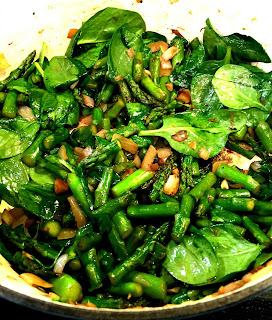I don't know about you, but I am SO ready for spring weather! I guess it's fair to say we New Englanders had a pretty easy winter, but I just am ready for it to be over! I'm ready for flowers to bloom, for the sun to be out, and to not have to wear my wool coat every day. I think my mindset with cooking has completely shifted to spring as well.
When I think of the "springiest" vegetable, asparagus comes to mind. Prior to this recipe I had never made asparagus soup, but I had been wanting to for a while. When I browsed some recipe ideas many of them called for milk or sour cream, but I opted to keep mine low-cal and dairy free and it still came out super creamy and delicious.
Funny enough, I was watching Food Network this morning and Trisha Yearwood was making asparagus soup. She suggested adding spinach to the asparagus to ensure the soup has a bright green color at the end. She said without it it'd be a very muted, non-appetizing green. Well, I followed her directions and the color came out gorgeous!
This is a SUPER easy recipe so feel free to get creative with the toppings. I served mine with some lemon zest and truffle oil, but you could add herbs, Parmesan or whatever you'd like.
Asparagus is such a healthy vegetable. It is known to prevent against certain types of cancer because it contains the detoxifying compound, glutathione which breaks down harmful free radicals. Asparagus is also a great source of Vitamin C which can ward off illness and Vitamin B which can promote brain health. Lastly, asparagus is a natural diuretic as it contains asparagine which is an amino acid that helps cleanse the body of excess salt.
Ingredients:
2 bunches of asparagus- chopped into 1 inch pieces
1 small yellow onion- diced
2 gloves garlic- minced
2.5 cups low sodium chicken or veggie stock
2 cups spinach
1 tbsp. olive oil
1/2 tsp. sea salt
1/4 tsp. black pepper
1 tbsp lemon zest for topping (optional)
1 tbsp truffle oil for topping (optional)
Directions:
1) Heat olive oil in a dutch oven over medium high heat.
2) Add asparagus pieces and onion and saute for 4-5 minutes.
3) Add garlic and cook for another minute or two until all vegetables are tender. Season with salt and pepper to taste.
4) Turn off the heat and add the spinach. Stir until spinach is slightly wilted- about 1 minute.
5) Add mixture and 2 cups of chicken stock to a blender. Blend on high until smooth. (You can also use an immersion blender as well- I unfortunately don't have one yet!)
6) Pour back into dutch oven with remaining 1/2 cup of chicken stock. Bring to a slight boil, then turn heat to low and simmer for 10 minutes.
7) Serve in bowls with desired toppings.
*Recipe makes roughly 4-5 servings








